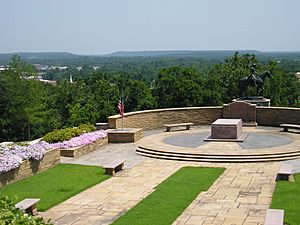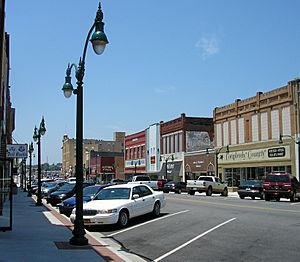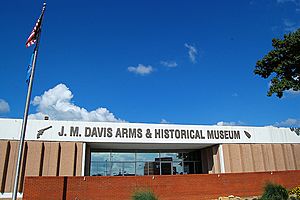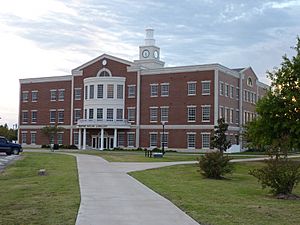Claremore, Oklahoma facts for kids
Quick facts for kids
Claremore, Oklahoma
|
|
|---|---|
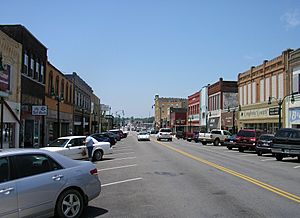
Downtown Claremore
|
|
| Motto(s):
"New Vision. Clear Opportunities."
|
|
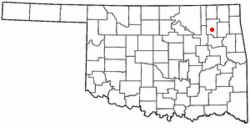
Location in the state of Oklahoma
|
|
| Country | United States |
| State | Oklahoma |
| County | Rogers |
| Incorporated | 1883 |
| Area | |
| • City | 15.07 sq mi (39.04 km2) |
| • Land | 14.81 sq mi (38.36 km2) |
| • Water | 0.26 sq mi (0.67 km2) |
| Elevation | 597 ft (182 m) |
| Population
(2020)
|
|
| • City | 19,580 |
| • Estimate
(2019)
|
18,743 |
| • Density | 1,265.31/sq mi (488.55/km2) |
| • Metro | 905,755 |
| Time zone | UTC-6 (CST) |
| • Summer (DST) | UTC-5 (CDT) |
| ZIP codes |
74017, 74018, 74019
|
| Area code(s) | 539/918 |
| FIPS code | 40-14700 |
| GNIS feature ID | 1091382 |
| Website | www.claremorecity.com |
Claremore is a city and the county seat of Rogers County in Green Country or northeastern Oklahoma, United States. The population was 19,580 at the 2020 census, a 5.4 percent increase over the figure of 18,581 recorded in 2010. Located in the foothills of the Ozark Mountains, the town is part of the Tulsa Metropolitan Area and home to Rogers State University. It is best known as the home of early 20th-century entertainer Will Rogers.
This area was part of the territory of the Osage, but they were forced out under a treaty with the United States. During the Indian Removal period and until statehood, this area was a reserve of the Cherokee Nation, which had been removed from its territory in the Southeast United States. This was within what was known as the Cherokee Cooweescoowee District.
Contents
History
Around 1802, a band of Osage Indians settled in the area of present-day Claremore. The town's name came from an Osage chief called "Gra-moi", French traders in the area pronounced his name as "Clairmont", which means "mountain with a clear view", The Osage village was destroyed in 1817, during the Battle of Osage Mound. The area experienced some minor damage during the American Civil War, but quickly recovered after the end of the conflict.
After the Indian Removal Act of 1830 was passed by the United States, Claremore became part of Indian Territory and the Cherokee Nation. Claremore was a part of the Cooweescoowee District in the northwestern part of the Cherokee Nation. The Rogers family, for whom the county is named, was among the first settlers. Clem Rogers, father of the famous Will Rogers, who, along with his family, is buried at the Will Rogers Memorial, moved to the county in 1856. His ranch, known as Dog Iron Ranch eventually was more than 60,000 acres (240 km2), and his home, which still stands outside Oologah, is an important historical site. Clem Rogers was a major advocate of Oklahoma statehood and was the oldest delegate to the state's Constitutional Convention in 1907 at age 69.
A post office was established on June 25, 1874. The coming of railways to Indian Territory was the driving factor in Claremore's early growth. Two early lines intersected in the center of town. The name of Claremore changed from Clermont to its present spelling on September 19, 1882. A clerk recording the town as having a post office spelled the name incorrectly, and it stuck. The city was incorporated in the Cherokee Nation on May 2, 1903.
Another major factor in the growth of Claremore was an area known as "Radium Town". In 1903, a man named George Eaton owned an oil company in Claremore. He had moved his family to Claremore area in 1874, where his principal businesses were farming and cattle raising. He subsequently branched into the mercantile business, real estate and oil exploration. He was drilling just to the east of Claremore and struck an underground pool of water that smelled of sulfur. A local doctor, Dr. W. G. Williams, tested the water and marketed it as a cure. The water, known as "Radium Water", contained no radium, but hydrogen sulfide and sulfur compounds that supposedly made it medically useful. Eaton then built a bath house and promoted this development as Radium Town. Bath houses sprang up all over this area of Claremore, but only one is still standing today. Radium Town was centered on 9th Street between Seminole and Dorothy in present-day Claremore.
Claremore's first hospital was established on Will Rogers Boulevard, or Oklahoma State Highway 20, in the early 1900s. Today it can be seen, with windows boarded up, just off the road. Claremore's newspaper, the Claremore Daily Progress, was established in 1893 by cowboy Joe Klein and is still published daily. It is the oldest business in Rogers County.
There are many historic homes and other buildings in Claremore, including the old business district. In 2002, Claremore's historic core received a rebuilding grant from the state's Oklahoma Main Street program. Renovation work on the downtown was completed in 2007.
Popular culture
The Rodgers and Hammerstein musical Oklahoma! is set in Claremore and the surrounding area, in 1906 (the year before Oklahoma became a State). The Quantum Leap (TV series) episode "8½ Months" is also set near Claremore. The movie Where the Heart Is starring Natalie Portman and Ashley Judd fictionally portrays Rogers County and the area surrounding Claremore.
Geography
Claremore is located at 36°18′55″N 95°36′46″W / 36.31528°N 95.61278°W (36.315181, -95.612784). According to the United States Census Bureau, the city has a total area of 12.3 square miles (32 km2), of which, 12.0 square miles (31 km2) of it is land and 0.2 square miles (0.52 km2) of it (1.96%) is water.
The city is located in Green Country, a popular nickname for northeast Oklahoma that stems from the region's green vegetation and relatively high amount of hills and lakes compared to central and western areas of Oklahoma. Claremore lies near the Verdigris River with undulating terrain producing hills and valleys. The city's primary water sources are Claremore and Oologah Lake, both within the drainage basin of the Verdigris River.
Climate
| Climate data for Claremore, Oklahoma | |||||||||||||
|---|---|---|---|---|---|---|---|---|---|---|---|---|---|
| Month | Jan | Feb | Mar | Apr | May | Jun | Jul | Aug | Sep | Oct | Nov | Dec | Year |
| Average high °F (°C) | 44.8 (7.1) |
50.3 (10.2) |
60.2 (15.7) |
71.2 (21.8) |
78.3 (25.7) |
86.3 (30.2) |
92.8 (33.8) |
92.0 (33.3) |
83.6 (28.7) |
73.6 (23.1) |
60.5 (15.8) |
48.8 (9.3) |
70.2 (21.2) |
| Average low °F (°C) | 21.2 (−6.0) |
26.1 (−3.3) |
35.7 (2.1) |
46.8 (8.2) |
55.7 (13.2) |
64.9 (18.3) |
69.5 (20.8) |
67.3 (19.6) |
60.4 (15.8) |
47.2 (8.4) |
36.5 (2.5) |
26.0 (−3.3) |
46.4 (8.0) |
| Average precipitation inches (mm) | 1.6 (41) |
2.0 (51) |
3.6 (91) |
3.6 (91) |
4.6 (120) |
4.6 (120) |
3.0 (76) |
3.1 (79) |
4.5 (110) |
3.6 (91) |
3.2 (81) |
2.2 (56) |
39.4 (1,000) |
| Source 1: weather.com | |||||||||||||
| Source 2: Weatherbase.com | |||||||||||||
Transportation
Claremore is a major intersection of heavily traveled highways. Interstate 44 crosses the town to its southeast. State Highway 66 (historic US-66) was designated along with one of the main east–west roads of the town. State Highway 88 and State Highway 20 intersect within the town.
Two railroad lines, the St. Louis, Iron Mountain, and Southern Railway line (now owned by Union Pacific) and the St. Louis-San Francisco Railway or "Frisco" line (now owned by BNSF) intersect in Claremore. The traffic problems resulting from the intersection of two major national rail lines have led to discussions among town officials about how best to improve traffic flow.
Claremore Regional Airport (KGCM; FAA ID GCM), is located about 7 miles east of Claremore, and features a paved 5200 x 75 ft. runway.
Commercial air transportation is available out of Tulsa International Airport, about 22 miles southwest.
Demographics
| Historical population | |||
|---|---|---|---|
| Census | Pop. | %± | |
| 1900 | 855 | — | |
| 1910 | 2,866 | 235.2% | |
| 1920 | 3,435 | 19.9% | |
| 1930 | 3,720 | 8.3% | |
| 1940 | 4,134 | 11.1% | |
| 1950 | 5,494 | 32.9% | |
| 1960 | 6,639 | 20.8% | |
| 1970 | 9,084 | 36.8% | |
| 1980 | 12,085 | 33.0% | |
| 1990 | 13,280 | 9.9% | |
| 2000 | 15,873 | 19.5% | |
| 2010 | 18,581 | 17.1% | |
| 2020 | 19,580 | 5.4% | |
| Sources: | |||
As of the census of 2000, there were 15,873 people, 6,283 households, and 4,165 families residing in the town. The population density was 1,319.4 people per square mile (509.4/km2). There were 6,784 housing units at an average density of 563.9 per square mile (217.7/km2). The racial makeup of the town was 75.69% White, 1.99% African American, 14.31% Native American, 0.44% Asian, 0.03% Pacific Islander, 1.12% from other races, and 6.42% from two or more races. Hispanic or Latino of any race were 3.02% of the population.
There were 6,283 households, out of which 33.6% had children under the age of 18 living with them, 49.6% were married couples living together, 12.4% had a female householder with no husband present, and 33.7% were non-families. 29.7% of all households were made up of individuals, and 13.8% had someone living alone who was 65 years of age or older. The average household size was 2.43 and the average family size was 3.02.
In the town, the population was spread out, with 26.7% under the age of 18, 9.0% from 18 to 24, 27.6% from 25 to 44, 19.8% from 45 to 64, and 16.9% who were 65 years of age or older. The median age was 36 years. For every 100 females, there were 89.5 males. For every 100 females age 18 and over, there were 86.1 males.
The median income for a household in the town was $34,547, and the median income for a family was $45,810. Males had a median income of $36,227 versus $21,742 for females. The per capita income for the town was $17,853. About 8.9% of families and 11.9% of the population were below the poverty line, including 15.4% of those under the age of 18 and 15.0% of those 65 and older.
Attractions
- J. M. Davis Arms and Historical Museum
- Will Rogers Memorial
- Will Rogers Downs
- Oklahoma Military Academy Museum
National Register of Historic Places
- Claremore Auto Dealership - now called "Claremore Tire," an old auto dealer in the central business district
- Eastern University Preparatory School - administration building of Rogers State University
- Mendenhall's Bath House - a historic building in "Radium Town"
- Maurice Meyer Barracks - a building on the campus of Rogers State University, contains OMA Museum
- Will Rogers Hotel - a hotel in downtown Claremore, now renovated for usage as apartments for senior citizens
Town twinning
Economy
Claremore's economy is diversified. Baker Hughes, an oil field services company, has a large presence in the town. Together with several other large companies, it is located in Claremore Industrial Park. This is only a few miles from the Tulsa Port of Catoosa, located on the Verdigris and Arkansas rivers. Coal mining is also an important industry; strip-style mines are operating on both the north and south sides of town.
Education
Claremore is home to the main campus of Rogers State University, which grants a master's degree and bachelor's and associate's degrees. The university serves more than 4,300 students. It is the only public four-year university in the Tulsa Metropolitan Area.
Claremore is also home to one of four campuses of Northeast Tech, a vocational training school. The Claremore campus serves over 200 students and offers both full-time and short-term classes.
Public school district serving Claremore is the Claremore Independent School District CISD consists of Claremore High School, Will Rogers Junior High, Catalayah Elementary, Westside Elementary, Claremont Elementary, Stuart Roosa Elementary, and the Alternative Learning Center.
The first school in the Claremore area was opened to students in 1870. The first major high school was built in 1919; it was the most expensive public school building in the state of Oklahoma at the time. The building was used as a school for almost 80 years, until 1999. The increasing costs of maintenance of the old building forced its closure.
Notable people
- Levy Adcock, football player
- Brad Carson, former U.S. Congressman
- Rotnei Clarke, basketball player
- Mercedes Lackey, author
- Patti Page, singer and entertainer
- Dave Rader, baseball player
- Lynn Riggs, playwright
- Will Rogers, entertainer, comedian, and actor
- Stuart Roosa, astronaut
- Kywin Supernaw, NFL player
- Kimberly Teehee, delegate-designate of the Cherokee Nation to the U.S. House of Representatives
- Helen Walton, philanthropist and wife of Walmart founder Sam Walton
- Madison Whitekiller, 2017-18 Miss Cherokee
Images for kids
See also
 In Spanish: Claremore (Oklahoma) para niños
In Spanish: Claremore (Oklahoma) para niños



